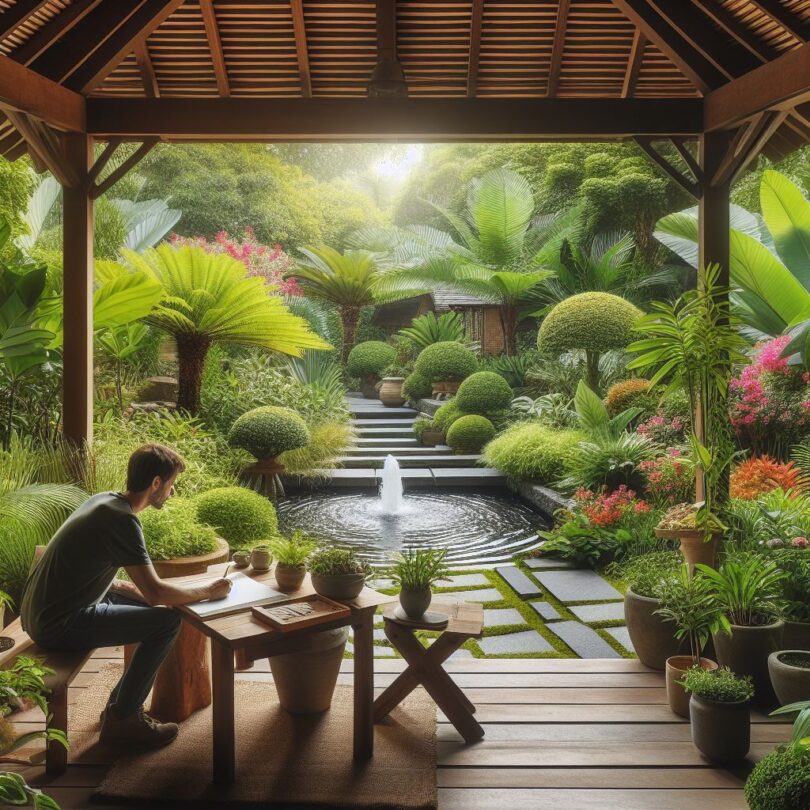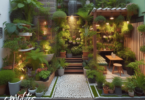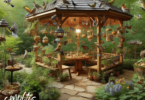Designing a shade garden requires careful planning and a keen eye for creating a serene oasis in a shaded space. With thoughtful landscaping and the right plant selections, you can transform your shaded garden into a visually stunning and peaceful retreat.

In this article, we will guide you through the process of shade garden design, from understanding the challenges posed by limited sunlight and competing tree roots to effectively assessing your shade conditions. We will also provide tips on selecting the perfect shade-loving plants, designing appealing layouts and pathways, incorporating hardscape elements, and maintaining the health and beauty of your shade garden.
Whether you have a small courtyard or a large backyard, a shade garden can be an enchanting addition to your outdoor space. Let’s explore the steps and considerations involved in creating a shade garden that thrives.
Key Takeaways:
- Designing a shade garden requires thoughtful planning and landscaping.
- Understanding the challenges of shade gardening is crucial for success.
- Assessing your shade conditions helps determine the appropriate plants for your garden.
- Choosing the right plants is key to creating a lush and vibrant shade garden.
- Designing visually appealing layouts and pathways enhances the overall ambiance of your shade garden.
Understanding the Challenges of Shade Gardening
Gardening in the shade presents unique challenges that can hinder the growth and health of your plants. To create a successful shade garden, it’s essential to understand and overcome these challenges. Let’s explore the common obstacles encountered in shade gardening and discover strategies to address them.
1. Limited Sunlight
One of the primary challenges in shade gardening is the reduced availability of sunlight. Shade gardens typically receive less than four hours of direct sunlight per day. This lack of sunlight can inhibit the growth and flowering of many plants that thrive in full sun conditions.
To compensate for limited sunlight, it’s crucial to select shade-tolerant plants that have adapted to lower light levels. These plants are better equipped to photosynthesize efficiently with less direct sunlight. Incorporating a variety of shade-loving perennials, ferns, and woodland plants will help create a diverse and vibrant shade garden.
2. Soil Moisture Levels
Shaded areas often have higher levels of soil moisture due to reduced evaporation. Excess moisture can lead to root rot, fungal diseases, and poor plant growth. It’s important to ensure proper drainage in your shade garden to prevent waterlogging and promote healthy plant growth.
Amending the soil with organic matter, such as compost or well-rotted manure, can improve drainage and enhance the soil’s ability to retain moisture without becoming waterlogged. Additionally, selecting plants that are adapted to moist soil conditions, such as hostas or astilbes, will thrive in the moisture-rich environment of a shade garden.
3. Competing Tree Roots
In many shade gardens, large trees provide the primary source of shade. However, these trees also compete with the surrounding plants for nutrients, water, and space. The dense network of tree roots can make it challenging for smaller shade garden plants to establish themselves and access essential resources.
To mitigate the impact of competing tree roots, create raised beds or utilize containers for planting. This will provide a controlled environment with enriched soil that is separate from the tree roots. When choosing plants for these areas, select those that can withstand competition and have shallow root systems.
“Shade gardens require careful planning and thoughtful plant selection to overcome the challenges posed by limited sunlight, soil moisture levels, and competing tree roots. By understanding these challenges and employing the right strategies, you can create a thriving and visually appealing shaded oasis.”
4. Lack of Plant Options
The limited availability of shade-loving plants can sometimes pose a challenge when designing a shade garden. While there may be fewer options compared to sun-loving gardens, there is still a wide variety of plants that thrive in shade.
It’s essential to research and choose plants that are well-suited to the specific light levels and growing conditions of your shade garden. Consider factors such as the plant’s shade tolerance, bloom time, foliage texture, and overall aesthetic appeal. By selecting a diverse range of shade-loving plants, you can create a visually stunning and dynamic shade garden.
To get started, here are some popular shade garden plants:
| Plant | Common Name | Height (inches) | Light Requirements | Hardiness Zones |
|---|---|---|---|---|
| Astilbe | False Spirea | 12-36 | Part Shade to Full Shade | 3-9 |
| Hosta | Plantain Lily | 6-36 | Part Shade to Full Shade | 3-9 |
| Fern | Various | 6-48 | Part Shade to Full Shade | Varies by Species |
| Bleeding Heart | Dicentra spectabilis | 18-30 | Part Shade to Full Shade | 3-9 |
Remember to consider your USDA Hardiness Zone and regional climate when selecting plants for your shade garden to ensure they are well-suited to your specific area.
By understanding the challenges of shade gardening and employing the right strategies, you can transform your shaded space into a thriving and visually appealing oasis. In the next section, we will explore how to assess your shade conditions to better plan your shade garden design.
Assessing Your Shade Conditions
In order to design a successful shade garden, it is crucial to understand the specific shade conditions in your garden. Assessing the type and duration of shade will help you determine the appropriate plants and design elements for your shaded oasis.
Determining Shade Levels
Shade conditions can vary widely, ranging from partial shade to full shade. It is important to evaluate the extent of shade in different areas of your garden to accommodate plants with varying shade tolerance. Assess the following shade levels:
- Partial Shade: Areas that receive filtered sunlight for a few hours each day. These areas typically offer more planting options and can support a greater variety of shade-loving plants.
- Dappled Shade: Areas that receive intermittent sunlight due to overhead tree canopies. These areas present unique opportunities for understory plants that thrive in dappled light.
- Full Shade: Areas that receive little to no direct sunlight. These areas may have dense tree cover or be located on the north side of a building. Plant selection for full shade areas requires careful consideration of shade-tolerant species.
Understanding Shade Types
Shade can also be categorized by its source or the elements causing the shade. Understanding the different shade types in your garden will further inform your plant selection and design decisions. The following shade types should be assessed:
- Tree Shade: Shade created by the canopy of trees. The density and spread of the tree branches will determine the intensity and extent of the shade in different areas of your garden.
- Building Shade: Shade cast by buildings, walls, or structures. This type of shade is typically more consistent and predictable throughout the day.
- Obstructed Shade: Shade caused by other objects such as fences, trellises, or neighboring plants. Obstructed shade may create pockets of unique microclimates within your garden, offering opportunities for diverse plantings.
Assessing Shade Duration
In addition to shade levels and types, it is important to determine the duration of shade in different areas of your garden. Some areas may experience longer periods of shade due to sun angles, obstructions, or surrounding structures. Take note of the amount of direct sunlight each area receives throughout the day to optimize plant placement and design.
By assessing the specific shade conditions in your garden, you will have a solid foundation for designing a shade garden that thrives. The knowledge of shade levels, shade types, and shade duration will guide your plant selection and layout decisions, ensuring a harmonious and lush shaded oasis.
Choosing the Right Plants for Your Shade Garden
Designing a shade garden requires careful consideration of the types of plants that will thrive in low-light conditions. When selecting plants for your shade garden, it’s important to factor in shade tolerance, bloom time, foliage texture, and overall aesthetic appeal. By choosing the right plants, you can create a beautiful and vibrant oasis in your shaded space.
Shade Tolerance
One of the most critical factors to consider when choosing plants for a shade garden is their shade tolerance. Some plants are better adapted to low-light conditions and can thrive with less direct sunlight. These shade-tolerant plants are the ideal choice for areas with dense shade throughout the day. Some popular shade-tolerant plants include:
- Hostas: Known for their lush foliage and variety of colors, hostas are a popular choice for shade gardens. They come in different sizes and shapes, allowing you to create interesting textures and patterns in your garden.
- Astilbes: These perennials are prized for their feathery plumes of flowers that bloom in shades of pink, red, and white. Astilbes are also known for their ability to attract butterflies and birds to your shade garden.
- Ferns: Ferns are a classic choice for shade gardens due to their ability to thrive in low-light conditions. Their delicate fronds add a touch of elegance and grace to any shady area.
Bloom Time
When planning your shade garden, it’s essential to select plants that bloom at different times throughout the growing season. This way, you can ensure that your garden is in full bloom from spring to fall. Consider combining early-blooming plants, such as bleeding hearts and hellebores, with later-blooming varieties like impatiens and begonias. This strategic planting will create a continuous display of color and ensure that your shade garden remains visually appealing throughout the year.
Foliage Texture
Texture plays a crucial role in the overall aesthetic appeal of a shade garden. By combining plants with different foliage textures, you can create depth and visual interest within your design. Consider pairing plants with broad, bold leaves, such as elephant ears, with delicate, lacy ferns for a striking contrast. Additionally, using plants with variegated foliage, like caladiums or ajuga, can add a touch of vibrancy and create a focal point within your shaded space.
Overall Aesthetic Appeal
When selecting plants for your shade garden, it’s essential to consider the overall aesthetic appeal you want to achieve. Think about the color palette, the mood you wish to create, and any specific themes or design styles you want to incorporate. For example, if you prefer a serene and calming atmosphere, opt for cool-toned flowers like asters and hydrangeas. Alternatively, if you want to create a vibrant and energetic space, choose plants with bold, contrasting colors, such as coleus or impatiens.
By carefully considering shade tolerance, bloom time, foliage texture, and overall aesthetic appeal during the plant selection process, you can design a shade garden that is not only visually stunning but also thrives in low-light conditions. Now that you have the knowledge to choose the right plants, let’s move on to the next section and explore the layout and pathway design options for your shade garden.
Designing Layouts and Pathways
When designing a shade garden, creating visually appealing layouts and pathways is key to enhancing the overall ambiance of the space. Thoughtful placement of plants, focal points, seating areas, and winding paths can transform your shady garden into a peaceful retreat. Here are some tips to help you design a shady garden that is both functional and visually stunning:
1. Choose the Right Plants and Organize Them Thoughtfully
Start by selecting shade-loving plants that complement each other in terms of height, color, and texture. Consider creating layers of plants to add depth and interest to your garden. Place taller plants at the back, medium-sized plants in the middle, and low-growing plants in the foreground.
You can create visually appealing patterns by grouping plants with similar colors or contrasting foliage textures. For example, pairing plants with variegated leaves alongside those with solid green foliage can create a striking visual display.
2. Create Focal Points
Focal points add interest and serve as visual anchors in a shade garden. Designate a focal point such as a sculpture, a beautifully crafted bench, or a unique plant specimen. Place it strategically along a pathway or at a central location where it can be admired from different angles.
“A well-chosen focal point can draw the eye and create a sense of intrigue in the shade garden.” – Garden Inspire
3. Incorporate Seating Areas
Designing a shady garden is not only about plants; it’s also about creating spaces for relaxation and enjoyment. Integrate seating areas where you can sit back and unwind amidst the tranquility of your garden. Place benches or outdoor chairs in shaded spots, allowing you to appreciate the beauty of your surroundings.
4. Design Winding Paths
Curved or winding paths can add a sense of mystery and discovery to your shade garden. Instead of straight pathways, opt for meandering ones that lead visitors through different areas of the garden. Use stepping stones, decorative gravel, or mulch to delineate the path and create a charming route.
By designing layouts and pathways with careful consideration, you can create a shady garden that is visually appealing and inviting. Whether you prefer a structured or more natural arrangement, the key is to ensure that each element works harmoniously to create a serene oasis.
| Advantages of Designing Layouts and Pathways in a Shade Garden | Disadvantages of Neglecting Layout and Pathway Design |
|---|---|
| Enhances the visual appeal of the gardenProvides a sense of structure and organizationCreates a focal point and adds interestFacilitates easy navigation | May result in a cluttered and disorganized appearanceNo clear focal point and lacks visual interestDifficult to navigate through the gardenLimited seating areas and relaxation spots |
Enhancing Your Shade Garden with Hardscape Elements
When it comes to shade garden design, incorporating hardscape elements can truly elevate the overall aesthetic and functionality of your outdoor space. Hardscape elements not only add structure and visual interest but also provide opportunities for creating focal points and defining different areas within your shade garden.
Pergolas are one of the most popular hardscape elements used in shade gardens. These wooden structures with open roof beams and columns offer shade and create a charming, intimate atmosphere. You can adorn the pergola with climbing plants, such as wisteria or clematis, to further enhance the natural beauty of your shade garden.
Stone walls are another great addition to a shade garden. They bring a sense of permanence and can serve as decorative elements while also providing seating opportunities. Stone walls can create terraces or elevated areas, allowing for better utilization of the available space in your shade garden.
If you’re looking to add a touch of tranquility and serenity to your shade garden, consider incorporating a water feature. A small fountain or a pond with gentle flowing water can create a soothing ambiance and attract birds and other wildlife to your garden. The sound of water can also help mask any unwanted noise, providing a peaceful retreat in your outdoor space.
Stepping stones or pathways can guide visitors through your shade garden and create a flowing, harmonious design. Choose natural materials, such as flagstone or gravel, to maintain the organic feel of the garden. These pathways can also lead to seating areas or hidden corners, inviting exploration and contemplation.
Integrating hardscape elements into your shade garden design requires careful planning to ensure they blend harmoniously with the surrounding vegetation. Consider the overall style and theme of your garden and select elements that complement your existing plantings and landscape.
“Incorporating hardscape elements into your shade garden design adds structure and visual interest, creating focal points and defining different areas within your outdoor space.”
Popular Hardscape Elements for Shade Gardens
| Hardscape Element | Description |
|---|---|
| Pergolas | Wooden structures with open roof beams and columns that provide shade and create a charming atmosphere. |
| Stone Walls | Decorative walls that add structure and seating opportunities while enhancing the overall aesthetic of the shade garden. |
| Water Features | Addition of fountains or ponds with flowing water to create a serene ambiance and attract wildlife. |
| Stepping Stones or Pathways | Natural stone or gravel pathways that guide visitors through the shade garden and create a harmonious flow. |
Maintaining and Caring for Your Shade Garden
Once you’ve created your beautiful shade garden, it’s important to maintain and care for it to ensure its health and longevity. Proper maintenance practices will help your shade garden thrive and continue to provide a lush oasis for years to come.
Watering Techniques for Shade Gardens
One of the key considerations for maintaining a shade garden is watering. While shaded areas typically have less direct sunlight, it’s important to ensure that your plants receive adequate moisture.
Pro Tip: Water your shade garden plants deeply and less frequently, focusing on providing thorough hydration to the root zone. This approach encourages deep root growth and helps the plants withstand periods of drought.
Fertilization for Healthy Growth
Another essential aspect of shade garden maintenance is providing adequate nutrients to support healthy growth. Regular fertilization will help your plants thrive and maintain their lush appearance.
Pro Tip: Choose a slow-release organic fertilizer specifically formulated for shade garden plants. Apply it in early spring and again in mid-summer to ensure a continuous supply of nutrients throughout the growing season.
Mulching to Conserve Moisture
A layer of mulch helps conserve moisture in a shade garden and suppresses weed growth. Additionally, mulching adds an aesthetic appeal by enhancing the overall visual cohesion of the garden.
Pro Tip: Apply a 2 to 3-inch layer of organic mulch, such as shredded bark or compost, around your shade garden plants. Be sure to keep the mulch several inches away from the plant stems to prevent moisture-related diseases.
Pruning for Healthy Growth and Shape
Regular pruning is essential for maintaining the shape and health of your shade garden plants. It helps control overgrowth, promotes airflow, and encourages new growth.
Pro Tip: Prune your shade garden plants during their dormant or early spring season to avoid interfering with their blooming period. Remove dead or damaged branches, as well as any crossing or crowded stems to maintain a well-structured and healthy garden.
Pests and Diseases to Watch Out For
While shade gardens are generally less prone to certain pests and diseases, it’s important to stay vigilant and address any issues promptly to prevent further damage.
Pro Tip: Inspect your shade garden regularly for common pests such as slugs, snails, and spider mites. Additionally, be on the lookout for signs of fungal diseases, such as powdery mildew or leaf spot. Treat any pest or disease issues using organic or targeted solutions to minimize environmental impact.
Incorporating these maintenance practices into your routine will help ensure the long-term health and beauty of your shade garden. By providing proper watering, fertilization, mulching, and pruning, as well as addressing any pest or disease issues promptly, you can enjoy a thriving and vibrant shade garden all season long.
Conclusion
Throughout this article, we have explored the art of shade garden design and discovered the transformative power it holds. By carefully selecting shade-tolerant plants, assessing shade conditions, and incorporating thoughtful design elements, you can create a shaded garden that is both visually stunning and serene.
With a keen eye for detail and a touch of creativity, you can turn the challenges of shade gardening into opportunities for innovation. By blending different textures, colors, and bloom times, you can craft an enchanting oasis amidst the shadows.
Remember, a successful shade garden is not just about the plants; it’s about creating a harmonious space where nature and design coexist. So whether you’re seeking shady corners for relaxation or yearning to breathe life into a neglected area, embrace the possibilities of shade garden design and let your imagination bloom.
FAQ
What is a shade garden?
A shade garden is a garden space that receives limited direct sunlight during the day. It can be created under the canopy of trees or on the north side of a building where sunlight is scarce.
What are the benefits of designing a shade garden?
Designing a shade garden offers several benefits, including creating a cool and tranquil space, providing a home for shade-loving plants, reducing the need for watering and maintenance, and adding visual interest to your landscape.
What are some shade-tolerant plants that I can consider for my shade garden?
Some popular shade-tolerant plants for shade gardens include hostas, ferns, astilbes, bleeding hearts, heucheras, and hellebores. These plants thrive in low light conditions and add beautiful foliage and blooms to your garden.
How do I assess the shade conditions in my garden?
To assess the shade conditions in your garden, observe the amount and duration of sunlight your garden receives throughout the day. You can also use a shade meter or consult a professional to determine the exact shade levels in different areas of your garden.
What hardscape elements can I incorporate into my shade garden?
Some hardscape elements that can enhance your shade garden include stone walls, pergolas, trellises, pathways, and water features. These elements not only add visual interest but also provide structure and functionality to your garden.
How do I maintain and care for my shade garden?
To maintain and care for your shade garden, it is important to follow regular watering, fertilization, and mulching practices. Additionally, pruning any dead or damaged foliage, monitoring for pests and diseases, and providing adequate soil nutrition are essential for the health and longevity of your shade garden.







